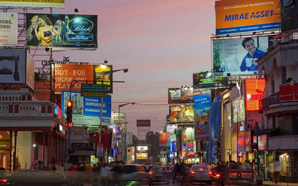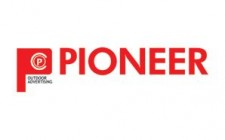OOH industry sceptical of BBMP's push for new ad policy
By VJ Media Bureau - April 28, 2016
Industry leaders question the civic body's elusive approach, impractical interventions and a general lack of vision to regulate OOH business in the city. While Bengaluru's OOH business landscape is cluttered and largely unregulated, it poses big risks to the industry's future business prospects.
 The Bruhat Bengaluru Mahanagara Palike (BBMP) Commissioner's decision to constitute a taskforce to draft a new advertisement policy for the city has raised the hackles of OOH media owners. While the BBMP had notified that the objective of the taskforce would be to revise the BBMP Advertising Bylaws of 2006 in keeping with the city's growth, OOH industry leaders assert that there is little wisdom in drafting a new advertising policy when some of the existing regulatory norms and good practices could not be enforced.
The Bruhat Bengaluru Mahanagara Palike (BBMP) Commissioner's decision to constitute a taskforce to draft a new advertisement policy for the city has raised the hackles of OOH media owners. While the BBMP had notified that the objective of the taskforce would be to revise the BBMP Advertising Bylaws of 2006 in keeping with the city's growth, OOH industry leaders assert that there is little wisdom in drafting a new advertising policy when some of the existing regulatory norms and good practices could not be enforced. The industry is peeved at the very composition of the taskforce which does not have any representation of the OOH advertising business. So, while the taskforce has representation from polity, administration and certain other domains, the BBMP has not felt the need to consider the OOH industry's collective viewpoint toward formulating the new advertising policy that would directly impact the course of OOH business in the city.
OOH business leaders maintain that the BBMP has evaded any step to discuss the industry's concerns although advertising revenues are a major source of income for the civic body, and indeed, those earnings could increase manifold if the regulatory norms were uniformly implemented. Moreover, as cities like Bengaluru look to upgrade the physical infrastructure including public utilities, many such projects would be increasingly executed through public-private partnerships (PPPs). The OOH industry would invariably partner some of those projects, like building skywalks, street furniture, public conveniences, etc., in lieu of advertising rights. However, the BBMP by keeping out the OOH industry leaders from policy consultations, has seemingly scuttled many a potential PPP project that would engage OOH players.
The BBMP notified in early January that the taskforce would be expected to come up with the new advertising policy in 90 days, which is, by early April this year. OOH industry leaders point out that it was only last year that the BBMP had decided to revise the bylaws whereby the advertising zones for the city were redefined. In fact, the industry had questioned the BBMP's decision then to place some of the key areas like the central business district in the'no advertising' zone. There seemed to be no rationale in the decision to keep advertising out of zones where the need to market products and brands is the highest as well as where movement of target audiences for most advertising brands is supposedly the highest. This was cited as another outcome of the BBMP's approach to formulating advertising norms without any discussion with the OOH business leadership.
 A few OOH media owners were deeply engaged in a key BBMP initiative to develop a portal-based system for licensing and renewal of media, but the civic body has abruptly decided to keep that system on hold. The BBMP had mandated that all licensing and renewals would be done online, which was expected to bring in transparency and operational efficiency into the system, but the civic body has stopped giving renewals and licenses citing regulatory violators - although the applicants are not individually informed of reasons why their applications have been rejected. As a result, while the system for media owners to pay their licensing fee has been severely disrupted, they are having to face the dire consequences of holding media assets that are deemed illegal as their licensing and renewals have not been sanctioned by the BBMP.
A few OOH media owners were deeply engaged in a key BBMP initiative to develop a portal-based system for licensing and renewal of media, but the civic body has abruptly decided to keep that system on hold. The BBMP had mandated that all licensing and renewals would be done online, which was expected to bring in transparency and operational efficiency into the system, but the civic body has stopped giving renewals and licenses citing regulatory violators - although the applicants are not individually informed of reasons why their applications have been rejected. As a result, while the system for media owners to pay their licensing fee has been severely disrupted, they are having to face the dire consequences of holding media assets that are deemed illegal as their licensing and renewals have not been sanctioned by the BBMP.OOH media owners state that the onus is still on them to pay the licensing and renewal fees, and that when the BBMP zonal officials raise tax demands on them, they are expected to pay the amount unconditionally. Any failure to meet such demands would invite severe action like bringing down their media assets.
Over the years, the BBMP has overlooked the mushrooming of illegal media across the city. So, there are an estimated 4,000-5,000 hoardings in the city, of which more than half are unauthorised. To root out unauthorised hoardings, a senior BBMP official took a tough stand to permit licensing and renewal of hoardings only after a BBMP staff or contractor takes actual measurement of the particular hoardings. The license fee would be accepted for renewal only if the media conforms to the prescribed dimensions. OOH industry leaders stated that such measures are impractical. For one, it would be time-consuming and laborious. Secondly, that would not prevent anyone from violating the norms once the measurements have been recorded.
To deal with the vast number of unauthorised hoardings, the BBMP official has apparently called for determining the duration that each unauthorised hoarding has been in existence -- based on the electricity bills paid for each such unit. Owners of such unauthorised hoardings would be required to pay the penalty for the entire duration their unauthorised media had been in operation --- and then bring down those unauthorised hoardings. As the BBMP does not have the financial wherewithal to bring down such hoardings, they would prevail upon the contractors to undertake this exercise whereby the contractors could set off the cost of bringing down the hoardings by selling the iron structures as scrap. The moot question is, would it be viable for the contractors to store and sell such a large quantity of scrap iron.
The one obviously apparent fact that stares one in the face during this unfolding saga is that till date no outright or stringent action has been taken against the blatantly illegal hoardings while all focus is on those who have applied through the online route for issue of licence for their hoardings. Faced with a situation of a vast number of illegal structures mixed with legal ones in the city, one would believe that the first obvious step would be to remove all the illegal ones. Only after that correction or policing, the legal ones need to be looked at.
In the midst of these steps, the bigger question being raised is whether the BBMP Council would entertain any measure that will stymie the earnings from advertising. Meanwhile, certain quarters of the OOH industry have called for regularisation of unauthorised hoardings through the'Akrama Sakrama' route whereby the media owners would pay the requisite licensing fee and have their media duly authorised.
It emerges that many of the media owners who would intently support uniform regulation of OOH advertising in the city are compelled by business reasons to deviate from the prescribed norms for hoarding dimensions. The reason being that a media conforming to the regulatory norm would be overshadowed by the over-sized media surrounding it, and so would lose out on client business. However, this situation would not come about of timely action is taken against unauthorised hoardings. This leads us to the question -- how such a large number of illegal hoardings were allowed to come up in the first place. This is the root cause for the scepticism with which all BBMP measures are today being viewed and the total loss of confidence in any BBMP measure that is announced.
To check land-owners and advertising brands from being associated with unauthorised media, the BBMP has cautioned land owners, advertisers and agencies that they would be penalised if they are party to any unauthorised media in the city. As a result, quite many agencies have pulled back or toned down OOH campaigns in the city, to the detriment of business interests of media owners with authorised media.
In the wake of these developments, the OOH business in the city is at the crossroads. There are several media owners who seek uniform and consistent enforcement of BBMP advertising norms but they find themselves bracketed with those running unauthorised media as well as all kinds of flexes that are randomly placed on the streets by various political groups.
Those who have erected unauthorised hoardings are now seeking regularisation of their media through the'Akrama Sakrama' route but will likely have to pander to the interests of conniving officials if the regularisation does not come about.
Certain senior BBMP officials who are determined to cleanse the OOH business through stringent regulation are exploring new ways to check rampant unauthorised media but could end up scuttling the business of even owners with authorised media.
And then, there is the BBMP Council which will continue to view hoardings as means to generate additional revenues for the cash-strapped civic body and so would be favourably disposed to authorise currently unauthorised media in the city, or possibly allow unauthorised media to exist and serve the interests of people who profit from such arrangements.
The OOH business in Bengaluru is in a state of flux, and OOH industry leaders in the city are not hopeful that the new advertising policy in the making will transform the OOH landscape and bring in uniform norms and transparency.
The Show Can't Go On
Even as the OOH industry in Bengaluru cites official apathy as a major stumbling block in the way of doing business in the city, the industry as a whole has observed scant regard for standard norms and practices. Taking advantage of the weak regulatory environment, the industry has flouted the advertising bylaws with impunity. The city OOH landscape is replete with over-sized hoardings, with many of them being completely unauthorised. While there are only around 2,000 authorised hoardings in the city, there are twice many hoardings that are unauthorised, but doing hot business.
It was apparently possible for many of those who installed unauthorised media to work the system to their favour in cohorts with conniving officials. But now, as certain BBMP officials have swooped down on deviant media business, a few sections of the industry are trying to have their media regularised through the'Akrama Sakrama' route.
While majority of the industry players seek to make capital of the flawed systems at work, the few players who don't entirely disregard regulation have also flouted the bylaws in order to be competitive in the business.
The OOH cityscape has ended up with high density presence in every high traffic area. At a time when many industries are working to earn the goodwill of city dwellers, the OOH industry seems to be oblivious of its social responsibilities. As far as the actual business is concerned, this has meant that rates for display have not only stagnated but have actually gone down leading to windfalls for unscrupulous agencies and their staff.
The cluttered OOH environment poses a big risk to the industry. For one, brands might begin to question the value of advertising in a space where they don't stand out and gain consumer attention. Secondly, the official machinery could take drastic steps to root out unauthorised media, which in turn might hurt the interests of businesses that observe the norms.
The industry lacks cohesion and so there is no concerted action to self-regulate the business. There are enough early warnings that OOH business could hit a brickwall if urgent corrective steps are not taken to self-regulate the industry.
Uniform norms the only panacea
The Indian Outdoor Advertising Association (IOAA) informs us that they had recently been mandated by the Union Ministry of Urban Development, through the PHDCCI, to submit a Comprehensive Framework for National Policy for Outdoor Advertising. This extensive exercise has recently been completed and submitted. This draft Framework is under discussion and will go through a consultative process before being adopted.
As such, the IOAA is confident that once this framework is adopted and made available to all states and municipalities, the current state of regulatory affairs will undergo a drastic change. The industry too will then come forward to ensure easy implementation of regulations. The timeframe, of course, is open to speculation, but given the urgency with which smart cities are being implemented, it is hoped that the national policy framework for outdoor advertising will also be opened for adoption equally speedily.

Stay on top of OOH media trends
Advertisement








